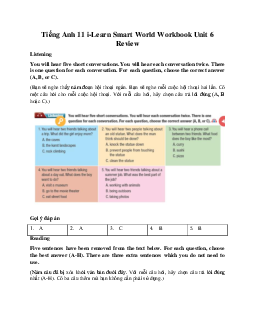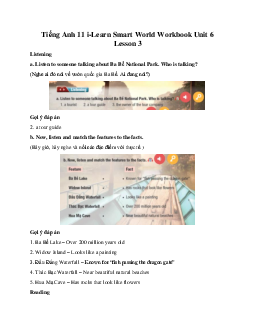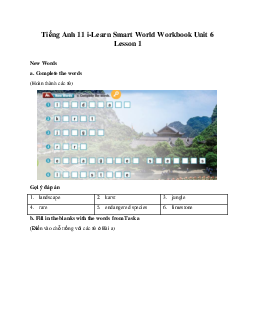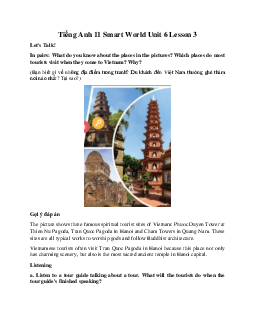









Preview text:
Tiếng Anh 11 Smart World Unit 6 Lesson 2 Let's Talk!
In pairs: How would you describe the building in the picture? Which old and
famous places would you like to visit? Why?
(Làm theo cặp: Bạn sẽ mô tả các tòa nhà trong bức tranh như thế nào? Những nơi cũ và
nổi tiếng bạn muốn đến thăm? Tại sao?) Gợi ý đáp án
The building in the picture looks very old and is carved quite finely, bearing many typical
historical architectural features.
I want to visit the tomb of King Khai Dinh because the architecture of Khai Dinh Tomb
brings something new, strange, unique, proud, out of place... created from architectural style. New Words
a. Read the sentences, then write the bold words in the conversation.
(Đọc các câu, sau đó viết các từ in đậm trong đoạn hội thoại.) Gợi ý đáp án 1. prevent 2. preserve 3. historical 4. knock down 5. statue 6. pass a law
b. In pairs: Do you know any historical buildings or heritages? What are they?
(Theo cặp: Bạn có biết tòa nhà hoặc di sản lịch sử nào không? Chúng là gì?)
Mỹ Sơn has many historical buildings.
(Mỹ Sơn có nhiều tòa nhà lịch sử.) Gợi ý đáp án
There are numerous historical buildings in India, and one of the most striking ones is the
Taj Mahal, which is located in Agra, Uttar Pradesh. It is a magnificent building and is
considered a symbol of India's architectural heritage. Listening
a. Listen to city officials discussing a preservation project. Do they agree on the plan?
(Lắng nghe các quan chức thành phố thảo luận về một dự án bảo tồn. Họ có đồng ý về kế hoạch không?) Gợi ý đáp án 1. yes
b. Now, listen and fill in the blanks.
(Bây giờ, hãy nghe và điền vào chỗ trống.) Gợi ý đáp án 1. present 2. cost 3. apartments 4. prevent 5. museum
c. Read the Conversation Skill box. Then, listen and repeat.
(Đọc hộp Kỹ năng đàm thoại. Sau đó, nghe và lặp lại.)
d. Now, listen to the conversation again and number the phrases in the order you hear them.
(Bây giờ, hãy nghe lại đoạn hội thoại và đánh số các cụm từ theo thứ tự bạn nghe được.)
e. In pairs: Do you think it's better to preserve old buildings or knock them down to build new ones? Why?
(Theo cặp: Bạn nghĩ tốt hơn nên bảo tồn các tòa nhà cũ hay đập bỏ chúng để xây dựng
những tòa nhà mới? Tại sao?) Gợi ý đáp án
I think if it is old buildings with historical value, they should be preserved to become
places to visit, and for ordinary old buildings, they should be demolished to build new
buildings to make houses for people.
Grammar Meaning and Use
a. Look at the picture. What do you think the men are saying?
(Nhìn vào bức tranh. Bạn nghĩ những người đàn ông đang nói gì?) Gợi ý đáp án
Should we repair the old apartments or knock them down?
I think we should repair them.
b. Now, listen and check your ideas.
(Bây giờ, hãy lắng nghe và kiểm tra ý kiến của bạn.) c. Listen and repeat.
(Lắng nghe và lặp lại.)
Grammar Form and Practice
a. Unscramble the sentences. (Sắp xếp lại câu.) Gợi ý đáp án
1. What should people do to promote tourism?
2. I think we should limit the number of visitors to national parks.
3. Universities should teach how to preserve old buildings.
4. How should we prevent people from damaging heritage sites?
5. Heritage sites should have lots of trash containers.
b. Match the beginning and end of the sentences. Then, read the sentences to your partner.
(Nối đầu và cuối câu. Sau đó, đọc các câu cho đối tác của bạn.) Gợi ý đáp án 1. b 2. c 3. d 4. e 5. a
c. In pairs: What are some natural or historical places in your area that are getting
older, damaged, or dirty? Which ones do you think should be preserved?
(Làm theo cặp: Đâu là một số địa điểm tự nhiên hoặc lịch sử trong khu vực của bạn đang
trở nên cũ kỹ, hư hỏng hoặc bẩn thỉu? Những cái nào bạn nghĩ nên được bảo tồn?) Gợi ý đáp án
Because it was built during the war of resistance against the French, the museum was old
and damaged. I think we should preserve it. Pronunciation Intonation
a. We use rise-fall intonation when we provide choice options
(Chúng ta sử dụng ngữ điệu tăng - giảm khi đưa ra các phương án lựa chọn)
b. Listen to the sentence and focus on how the intonation rises then falls.
(Nghe câu nói và tập trung vào cách ngữ điệu lên xuống.)
c. Listen and cross out the sentence with the wrong intonation.
(Nghe và gạch bỏ câu có ngữ điệu sai.) Gợi ý đáp án
Should we prevent people from cutting down trees or put up signs saying "Don't leave trash"?
- Wrong. Intonation falls then rises.
d. Read the sentences with the correct intonation to a partner.
(Đọc các câu với ngữ điệu chính xác với đối tác.) Practice
a. Ask questions about the problems. Give your opinion (using the possible solutions
or your own ideas), and then ask for your partner's opinion.
(Đặt câu hỏi về các vấn đề. Đưa ra ý kiến của bạn (sử dụng các giải pháp khả thi hoặc ý
tưởng của riêng bạn), sau đó hỏi ý kiến của đối tác của bạn.) Gợi ý đáp án
How should we prevent pollution of our heritage sites?
Should we prevent tourists from using plastic bags, cups or make people pay if they throw trash?
I think we should make people pay if they throw trash.
b. Practice with your own ideas.
(Thực hành với ý tưởng của riêng bạn.) Gợi ý đáp án
How should we prevent damage to natural historical sites?
I think we should renovate and rebuild. The regular check is the procedure the
government or response companies most commonly use. Speaking
PRESERVING OUR HERITAGE (Bảo tồn di sản văn hóa của chúng ta)
a. In pairs: Choose a world heritage site from below or another site you know. List
the possible problems the site may have, eg, not being famous, pollution, damage,
etc. Discuss the best ways of dealing with those problems to best preserve the site.
(Theo cặp: Chọn một địa điểm di sản thế giới từ bên dưới hoặc một địa điểm khác mà bạn
biết. Liệt kê các vấn đề có thể xảy ra mà địa điểm có thể gặp phải, ví dụ: không nổi tiếng,
ô nhiễm, hư hỏng, v.v. Thảo luận về cách tốt nhất để giải quyết những vấn đề đó để bảo
tồn địa điểm tốt nhất.) Gợi ý đáp án
- The possible problems Hội An Ancient Town may have:
+ Pollution of the environment due to littering tourism and domestic waste. + Storms cause flooding.
+ The transformation and accretion of rivers and flows cause riverbank erosion,
threatening the villages along the river routes and even the Old Quarter.
- The best ways of dealing with those problems to best preserve the site:
+ Raise community awareness in dealing with the natural environment.
+ Make people pay if they throw trash.
b. Join another pair and tell them the site you chose. Share the problems you think
it may have, and your solutions.
(Tham gia một cặp khác và cho họ biết địa điểm bạn đã chọn. Chia sẻ những vấn đề bạn
nghĩ nó có thể có và giải pháp của bạn.)




